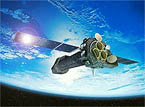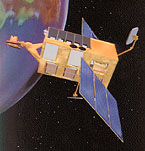 The HEASARC is NASA's designated multi-mission astronomy archive for cosmic
astronomy datasets for observations in the extreme ultraviolet (EUV),
X-ray, and gamma-ray wave bands, as well as for cosmic microwave background
(CMB) datasets. Because EUV, X rays and gamma rays cannot reach the
Earth's surface due to the opacity of the Earth's atmosphere,
it is necessary to place the telescopes and sensors for these wave bands on
spacecraft. The HEASARC holds EUV, X-ray and gamma-ray data from 32
observatories (as of 2016) which operated over the last half a century. The
data and software from many of the older missions were restored by the HEASARC
staff. Examples of these archived missions include
ASCA,
BeppoSAX,
Chandra,
Compton GRO,
HEAO 1,
Einstein Observatory (HEAO 2),
EUVE,
EXOSAT,
HETE-2,
INTEGRAL,
ROSAT,
Rossi XTE,
Suzaku,
Swift, and
XMM-Newton.
The HEASARC is NASA's designated multi-mission astronomy archive for cosmic
astronomy datasets for observations in the extreme ultraviolet (EUV),
X-ray, and gamma-ray wave bands, as well as for cosmic microwave background
(CMB) datasets. Because EUV, X rays and gamma rays cannot reach the
Earth's surface due to the opacity of the Earth's atmosphere,
it is necessary to place the telescopes and sensors for these wave bands on
spacecraft. The HEASARC holds EUV, X-ray and gamma-ray data from 32
observatories (as of 2016) which operated over the last half a century. The
data and software from many of the older missions were restored by the HEASARC
staff. Examples of these archived missions include
ASCA,
BeppoSAX,
Chandra,
Compton GRO,
HEAO 1,
Einstein Observatory (HEAO 2),
EUVE,
EXOSAT,
HETE-2,
INTEGRAL,
ROSAT,
Rossi XTE,
Suzaku,
Swift, and
XMM-Newton.

CMB observations can be made either from space, balloons or from the ground.
The HEASARC's LAMBDA website
holds data obtained by the COBE and WMAP satellite
observatories (and also from the SWAS sub-mm observatory),
as well as from more than 20 balloon- and ground-based experiments.
The HEASARC and LAMBDA
scientists
are recognized in their own right as world-class researchers. They provide
the essential ingredient to the HEASARC's success by using the archival
data for their own research.
The HEASARC on-line service is an archive
and database system accessible through the networks that provides rapid access
 to the entire HEASARC data holding either directly via ftp, or using the Xamin, Browse
and/or
SkyView interfaces to search the HEASARC catalogs and access the
data. The analysis tools to work
on these data sets are also
provided via the HEASARC Software web pages.
A High Energy Astrophysics Learning Center provides
education and outreach activities.
to the entire HEASARC data holding either directly via ftp, or using the Xamin, Browse
and/or
SkyView interfaces to search the HEASARC catalogs and access the
data. The analysis tools to work
on these data sets are also
provided via the HEASARC Software web pages.
A High Energy Astrophysics Learning Center provides
education and outreach activities.
 The HEASARC is very active in promoting data format standards and has
promoted the Flexible Image Transport
System (FITS)
as a standard for all level of data. As part of this effort, the FITSIO library of software
has been developed to handle FITS files to be written, read, and
manipulated.
The HEASARC is very active in promoting data format standards and has
promoted the Flexible Image Transport
System (FITS)
as a standard for all level of data. As part of this effort, the FITSIO library of software
has been developed to handle FITS files to be written, read, and
manipulated.
The HEASARC develops multi-mission analysis tools that facilitate the
comparison and analysis of high level data in the archive (e.g. spectral analysis).
The HEASARC will be providing software and a data archive for new missions
such as Hitomi (formerly Astro-H) (launched in
February 2016), and for upcoming missions
that will launch soon, such as NICER (late 2016).
|




